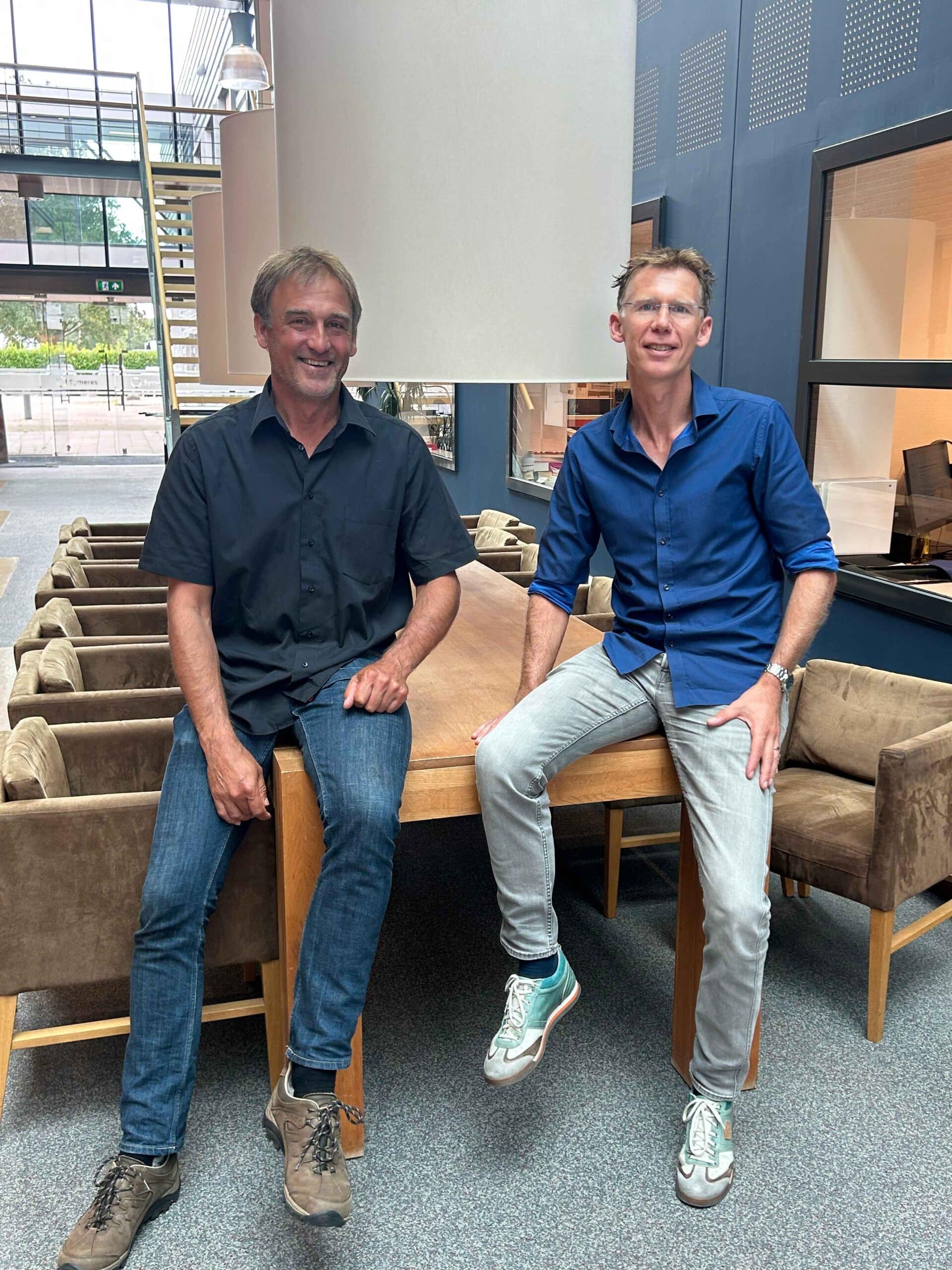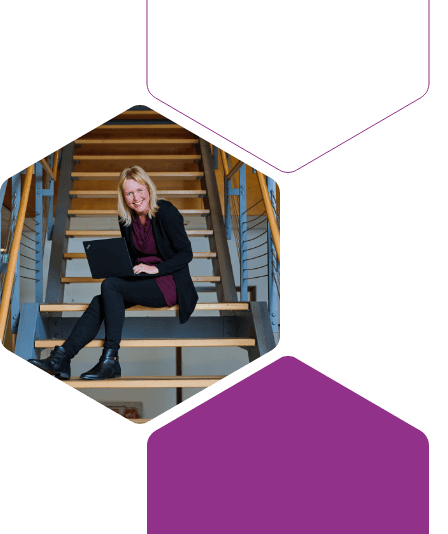Recently, our colleague Peter Molenveld celebrated his 25th anniversary with Symeres. Peter participated in an interview where he shared about his time with Symeres and his growth here as a chemist to leadership within the organization, as well as about his role as secretary at the Royal Netherlands Chemical Society (KNCV).

What made you decide to study chemistry?
I was always very convinced that I should do chemistry. In high school, I really liked this subject, and I had a great teacher who steered me to study chemistry. Then, I pursued my BSc in chemistry at a university of applied sciences (Dutch HLO) at Hogeschool Enschede (based in Hengelo) and passed after doing an internship at Organon in Oss, which was the biggest pharmaceutical company in the Netherlands at that time.
However, I thought to myself that this wasn’t enough and that I should do a master’s degree as well. So, then I moved to Nijmegen to do my MSc in chemistry at Radboud University with a focus on organic chemistry, where I had a great internship experience in the group of Professor Zwanenburg.
Afterward, I went to the University of Twente to do my PhD under Professor David Reinhoudt and Professor Johan Engbersen on the subject “Synthetic metallophosphodiesterases based on calix[4] arenes,” focused on bioorganic/supramolecular chemistry and catalysis (80% organic synthesis). So, the project focused on studying enzyme models, specifically mimicking catalytic phosphate ester hydrolysis.
And then you had finished your PhD and you decided to apply to Mercachem?
Funny story, actually. I already knew Eelco Ebbers from my MSc internship in Professor Zwannenberg’s group at Radboud University. In the final stage of my PhD, I attended a KNCV organic chemistry symposium at DSM Geleen. During the coffee break, I ran into Eelco and had a conversation with him. He then invited me to apply for a position at Mercachem, which at the time was a very small company with only six employees. I was interviewed for a position and was selected to join the company in May 1999 as employee number seven. It feels like a century ago!
Then you decided to stay for 25 years. There must be some things you really liked about the company. Can you tell us a bit about the company?
Yes, of course, I enjoy organic chemistry research, but it’s also about the people and the atmosphere within the company. Over the course of 25 years, both the company and my role have changed significantly. In the beginning, I was doing lab work myself until 2006, and at that time, we already had more than 80 synthetic chemists at Mercachem. In the early days, there were no departments or service platforms, so we had to arrange everything ourselves.
As we grew, we introduced more structure and organized departments. Eventually, we were acquired by an investor and brought in other companies, which led to new challenges, such as collaborating with different sites. Everything evolved, which made my position more dynamic over time. It’s certainly not the same as it was 20 years ago, but I still enjoy the combination of science and line management/organization. Throughout these 25 years, I’ve never considered applying elsewhere because I’ve always been happy in my job.
Symeres specializes in small molecules, can you speak to that? How has the chemistry field changed in the past 25 years, and how has that influenced the direction projects have taken scientifically?
Small molecules are our core business, but in my experience, we are seeing an increasing number of projects involving larger molecules. Target structures have expanded beyond the traditional small “Lipinski rule of five” compounds used for medicinal chemistry to include larger, more complex entities such as fatty molecules, nucleotides, linkers, and conjugates. Lipinski’s rule of five serves as a guideline to assess the drug-likeness of a chemical compound, predicting its potential to be orally active in humans based on properties like molecular weight, lipophilicity, polar surface area, hydrogen bonding, and charge.
Innovative synthetic methods, such as electrochemistry and photocatalysis, have been developed and successfully implemented within the company. Additionally, advances in chemical analysis, driven by improved equipment and software, have significantly enhanced both speed and accuracy. More efficient purification methods, such as supercritical fluid chromatography (SFC) and preparative LCMS, have been introduced, allowing for much faster processing than ever before. At Symeres, we are excelling in these areas.
At Symeres, we are really doing well in this field, but organic chemistry is still regarded as a bit of an old-fashioned craftwork. Do you agree with that, Peter?
I agree to some extent, but particularly in the academic world, there’s a prevailing notion that every molecule found in nature can be prepared. While this is theoretically true, it’s not always practical. With enough resources, it might be possible, but the reality is far more challenging. Inventing a new reaction or synthesizing complex structures in meaningful amounts is often a difficult and resource-intensive process.
While organic chemistry is often still viewed as a traditional craft, it requires both intelligence and creativity. For instance, data mining is becoming increasingly important in the field. It’s crucial to examine what has been done both inside and outside of the company, as well as to find the right literature and methods that can be applied to your own target molecules.
Can you think back and share a memory of the most impressive projects or those that you were most proud of?
Yeah, there are many projects I’m proud of, but I will try to describe three from different time periods. One project I am particularly proud of is the lab work I did in 2003 on metabolite and prodrug synthesis for a Belgian biopharmaceutical company, Tibotec, which no longer exists. I was proud of it because the synthesis was difficult. If we were to do it today, we would have it completed within one week, but at the time, it was very challenging. The collaboration with the customer was also great, with visits to each other, which made it even more rewarding.
The next project I really enjoyed was with Dr. August Wolff GmbH & Co. KG Arzneimittel, a German company specializing in dermatological pharmaceuticals and cosmetics, which started a medicinal chemistry program with a small research group. This project was one of the first larger medicinal chemistry projects at Mercachem.
Together with Geert Jan Sterk, I was the project manager, and the project resulted in two publications. Through this experience, I gained valuable knowledge in medicinal chemistry, including biological assays, compound profiling, and collaborating with CROs and universities. The customer frequently visited us on-site, and we also visited them often, making the collaboration very successful.
Finally, I had another three-way collaboration from 2020 to 2022 with a German customer, Cfm Oskar Tropitzsch GmbH, and US-based Vedere Bio II. In this project, we prepared dendrimer-like structures with molecular weights of 4–5 kDa, featuring a high diversity of functionalities, including dyes, PEG linkers, peptides, and a cleavable group. The therapeutic area was vision restoration and preservation for patients with vision loss. This project was outside the usual scope of our core business in heterocyclic small molecules.
Many talented chemists at Symeres contributed to the project. It involved very challenging chemistry but was ultimately successful.
Let’s talk about your role in the Royal Netherlands Chemical Society (KNCV) and the European Federation for Medicinal Chemistry (EFMC). What are you doing there? Why were you asked to take on your role?
The KNCV is a professional association that supports the Dutch chemical community by organizing networking and scientific meetings, awarding prizes, bringing together different disciplines, and publishing the monthly magazine C2W and e-newsletters.
My involvement began 12 years ago when Professor Ad IJzerman from Leiden University asked me to become secretary of the board for the Medicinal Chemistry and Chemical Biology (MCCB) division of the KNCV. I held this position for nine years, which greatly expanded my knowledge of medicinal chemistry and broadened my network both within and outside the Netherlands. As part of this role, I also served as the Dutch representative for the European Federation for Medicinal Chemistry (EFMC) for three years.
In 2021, the KNCV invited me to join the sponsor committee for the International Union of Pure and Applied Chemistry (IUPAC)/CHAINS World Chemistry Conference 2023 in The Hague. In this capacity, I collaborated with the Dutch Research Council (NWO) to secure and contract sponsors. Following this, Jan-Willem Toering, Director of the KNCV, asked me to join the KNCV board, and I have served as the KNCV secretary since December 2023.
As for how long I will maintain my current position, that’s hard to say—it depends on the needs of the organization and the opportunities that arise in the future.
How long will you maintain your current position as secretary of the KNCV?
The timeframe for being a board member of the KNCV is three years. After this period, you can be re-elected for another three-year term if desired.
You have seen the company grow from 7 to 700 employees, but when you look to the future for Symeres now, what do you see?
Yeah, we have been in business for a long time, and in my 25 years with the company, more than 23 of those have been focused on growth and recruiting people. While, like any industry, there are challenges, Symeres has built a very diverse portfolio that will continue to expand and develop the organization. Fortunately, our chemists are highly educated and adaptable, allowing us to allocate early R&D chemists to process R&D programs and vice versa.
Any advice for young chemists starting out their careers?
Yeah, you should just select a study that you really like and follow your gut. While it might be difficult to find a job in organic chemistry in the Netherlands due to the limited number of R&D companies, there are alternative paths to other disciplines or careers outside of this field that are definitely possible.

